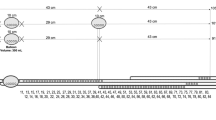Abstract
PURPOSE: A direct comparison of anal sphincter physiology (muscle performance and anatomy-muscle thickness) has not yet been undertaken but may be of importance in patients with defecation disorders. METHODS: We evaluated 15 healthy volunteers by means of anorectal manometry to determine pressure functions of the internal and external anal sphincter. Transcutaneous electromyography was recorded to assess the electrical activity of the external anal sphincter. Thickness of the anal sphincter muscles was measured sonographically from within the anal canal with dorsal projection using a 7.5-MHz 360° rectal panorama scanner. RESULTS: It was shown that neither is the muscle thickness of the external anal sphincter during rest (6.26±1.02 mm) or during squeezing (7.40±1.39 mm) correlated to its squeeze pressure (138.8±15.2 mmHg), nor is the diameter of the internal anal sphincter (2.09±0.58 mm) correlated to its resting pressure (61.1±15.2 mmHg). Finally, the thicker the internal anal sphincter muscle, the lower the electrical activity of the external anal sphincter during squeezing (r=0.74,P <0.001). CONCLUSION: It is concluded that both manometry to assess sphincter function and sonography to determine sphincter morphology are important measures in the evaluation of continence function.
Similar content being viewed by others
References
Read NW, Bannister JJ. Anorectal manometry: techniques in health and anorectal disorder. In: Henry M, Swash M, eds. Coloproctology and the pelvic floor. London: Butterworth, 1984:65–87.
Enck P, Kuhlbusch R, Lübke H, Frieling T, Erckenbrecht JF. Age and sex and anorectal manometry in fecal incontinence. Dis Colon Rectum 1989;32:1026–30.
Kumar D, Williams NS, Waldron D, Wingate DL. Prolonged manometric recording of anorectal motor activity in ambulant human subjects: evidence of periodic activity. Gut 1989;30:1007–11.
Enck P, Eggers E, Bielefeld K, Koletzko S, Erckenbrecht JF. Spontaneous variation of anal “resting” pressure in healthy humans. Am J Physiol 1991;261:G823–6.
Orkin BA, Hansen RB, Kelly KA, Phillips SF, Dent J. Human anal motility while fasting, after feeding, and during sleep. Gastroenterology 1991;100:1016–23.
Pittman JS, Benson T, Summers JE. Physiologic evaluation of the anorectum: a new ultrasound technique. Dis Colon Rectum 1990;33:476–8.
Law PJ, Kamm MA, Bartrams CI. A comparison between electromyography and anal endsonography in mapping external anal sphincter defects. Dis Colon Rectum 1990;33:370–3.
Kamm MA, Hoyle CH, Burleigh DE,et al. Hereditary internal anal sphincter myopathy causing proctalgia fugax and constipation. Gastroenterology 1991;100:805–10.
Eckardt VF, Nic W. The anal sphincter in patients with myotonic dystrophy. Gastroenterology 1991;100:424–30.
Burnett SJD, Bartrams CI. Endosonographic variation in the normal internal anal sphincter. Int J Colorectal Dis 1991;6:2–4.
Law PJ, Kamm MA, Bartrams CI. Anal endosonography in the investigation of faecal incontinence. Br J Surg 1991;78:312–14.
Felt-Bersma RJ, Strijers RI, Janssen JJW, Visser SI, Meuwissen SG. The external anal sphincter. Relationship between manometry and anal electromyography and its clinical relevance. Dis Colon Rectum 1989;32:112–6.
Wexner SD, Marchetti F, Salanga VD, Corredor C, Jagelman DG. Neurophysiologic assessment of the anal sphincter. Dis Colon Rectum 1991:34:606–12.
Pinho M, Hosie K, Bielecki K, Keighley MR. Assessment of non-invasive intra-anal electromyography to evaluate sphincter function. Dis Colon Rectum 1991;34:69–71.
Binnie NR, Kawimbe BM, Papachrysostomou M, Clare N, Smith AN. The importance of the orientation of the electrode plate in recording the external anal sphincter EMG by non-invasive anal plug electrodes. Int J Colorectal Dis 1991;6:5–8.
Enck P, Rühl A, Gantke B. Biofeedback training for fecal incontinence. ColoProctology 1992;14:204–8.
Bleijenberg G, Kuipers HC. Treatment of spastic pelvic floor syndrome with biofeedback. Dis Colon Rectum 1987;30:108–11.
Author information
Authors and Affiliations
Additional information
This work was supported by Grant En0/10 from the Deutsche Forschungsgemeinschaft.
About this article
Cite this article
Gantke, B., Schäfer, A., Enck, P. et al. Sonographic, manometric, and myographic evaluation of the anal sphincters morphology and function. Dis Colon Rectum 36, 1037–1041 (1993). https://doi.org/10.1007/BF02047296
Issue Date:
DOI: https://doi.org/10.1007/BF02047296




